IASbaba's Daily Current Affairs Analysis
Archives
(PRELIMS & MAINS Focus)
Syllabus
- Prelims – Science and Technology
Context: The government of India has approved a Rs 124 crore proposal for setting up incubation centres in the Delhi and Bengaluru campuses of the Centre for Development of Telematics (C-DoT) under the Digital Communication Innovation Square (DCIS) under Champion Services Sector Scheme.
About The Centre for Development of Telematics (C-DOT):
- Centre for Development of Telematics (C-DOT) was established in August 1984 as an autonomous Telecom R&D centre of Dept o Telecommunication, Govt. of India.
- It is a registered society under the Societies Registration Act, 1860.
- It is a registered ‘public funded research institution’ with the Department of Scientific and Industrial Research (DSIR), Ministry of Science & Technology, Government of India.
- C-DOT as a torch bearer of indigenous telecom R&D continues to develop latest technology products in areas like Optical, Switching, Wireless, Security and Network Management while also working on futuristic technologies like M2M/IOT, 5G, AI, etc.
- C-DOT reiterates its unequivocal commitment to the betterment of country’s telecom sector by working towards realizing the objectives of various flagship programs of the Government of India that include Digital India, Make in India, BharatNet, Skill India, Startup India and Smart Cities.
- Chairman: Union Minister of Communication & IT
- Vice Chairman: Union Minister of State for Communication & IT
- Members: 10 other members from various ministries and telecom sectors
- Customer Segments: Defence organizations & Strategic agencies, public sector / Govt. , Educational institutions, Manufacturing sector / Toll Operate Transfer partners, TSPs and ISPs etc
Success stories of C-DOT:
- Launch of Gyan Setu and MAXNG Technologies:
- ‘GyanSetu’ is an internet based real-me ICT system designed by C-DOT, primarily to provide various eservices to the under privileged rural population of India.
- MAX-NG, C-DOT’s Next Generation Network (NGN) solution addresses the needs of the changing telecom scenario and enables a smooth transition from Plain Old Telephone System (POTS) to NGN based Voiceover-IP (VoIP).
- Launch of Broadband Products:
- During Digital India Week, C-DOT launched four products and inaugurated IMS compliant NGN Services in MTNL network.
- High Speed, long distance Wi-Fi solution is Ideal for increasing the penetration of broadband services in difficult and inaccessible terrains e.g., hilly areas, dense vegetation, islands, unconnected villages. disaster sites, border areas, tunnels, Battlefield Surveillance.
- Inauguration of Terabit Router & FTTD Solution:
- C-DOT has designed and developed India’s first indigenous Terabit Router.
- Hon’ble Minister of Communications & IT inaugurated C-DOT Terabit Router along with GPON based Fibber-to-the-Desk solution (FTTD) during a TSDSI function held at C-DOT Campus in October 2014.
Awards & Accolades:
- KSCST IP Award and Rewards 2021:
- C-DOT has been awarded the KSCST IP Award and Rewards 2021 in appreciation and recognition for the contribution in the field of IPRs under the R&D Institute category.
- AEGIS Graham Bell Award 2019:
- 10th edition of Aegis Graham Bell Awards for Innovative Telecom Product
- WBA Industry Award 2018
- C-DOT Wi-Fi Solution won the most prestigious International Award at Wireless Broadband Alliance (WBA), London in the category “Best Wireless Deployment in Rural or Remote Areas Award”.
Source: EconomicTimes
Previous Year Questions
Q.1) Consider the following communication technologies:
- Closed-circuit Television
- Radio Frequency Identification
- Wireless Local Area Network
Which of the above are considered of the Short-Range devices/technologies? (2022)
- 1 and 2 only
- 2 and 3 only
- 1 and 3 only
- 1, 2 and 3
Q.2) With reference to visible light communication (VLC) technology, which of the following statements are correct? (2020)
- VLC uses electromagnetic spectrum wavelengths 375 to 780nm
- VLC is known as long-range optical wireless communication
- VLC can transmit large amounts of data faster than Bluetooth
- VLC has no electromagnetic interference
Select the correct answer using the code given below
- 1, 2 and 3 only
- 1, 2 and 4 only
- 1, 3 and 4 only
- 2, 3 and 4 only
Syllabus
- Prelims – Art and Culture and Environment
Context: Odisha’s Kutia Kondh tribe worship and exchange millet seeds in a celebration during Burlang Yatra festival.
About Kutia Kondh Tribe/ Tribes of Kalahandi:
- Kutia Kondha is one of the primitive sections of Kondha tribe.
- The Kondha’s who live in hill top and valleys are known as Kutia Kondha.
- Whereas those who live in high land and near the streams are called Dongria Kondha and kondhas who are residing in plain area are known as Desia kondh.
- Kutia kondh are mostly dependent on shifting cultivation, cultivation of minor agriculture products and collection of NTFP.
- The Kutia kondhs are residing mostly in Langigarh,Th.rampur,M.Rampur and Bhawanipatna block of Kalahandi.
- They practice shifting cultivation, cultivating varieties of crop and during lean period collecting food stuffs from the forest.
- Minor forest products also fetch them cash income.
- The social organization is very strong and unified. The family is mostly nuclear and patriarchal in character. Social unity and co-operation is remarkable. Women play a bigger role in the family economy.
- They are mostly nature worshipper.
- Jani is the fulltime magic religious specialist of the village.
- In the pre-independence era, they were practicing human sacrifice but now a day as substitute buffalo and sheep sacrifice.
- The practice of youth dormitory are though gradually losing its importance but still prevalent among Kutia kondh villages.
- Dhap, Salap Baja are the important musical instruments of Kutia Kondhs.
About Burlang Yatra Movement:

- A movement built around the Burlang Yatra, a traditional festival of the ‘Kutia Kondh tribe’ of Odisha, has involved traditional millet crops in reviving their ancient food palate.
- In collaboration with Millet Network of India (MINI), a forum founded for the promotion of millet, NIRMAN started celebrating the Burlang Yatra on a large scale to increase awareness about millet.
- In the past, millet used to be the staple food for tribals in Odisha. When paddy and other foods reached their doorstep through the public distribution system and the expanding consumer market, tribals started treating millets as subsistence crops that they grew to use or eat for themselves rather than to sell.
- Some millet started to disappear from the tribal food basket.
- In 2017, the Odisha government realized the importance of highly nutritious and climate-resilient millets in tribal society.
- The Odisha government has also started celebrating ‘Mandia Dibas’ (Millet Day) on November 10 to popularise the crop.
MUST READ: Odisha’s Millets Mission
Source: The Hindu
Previous Year Question
Q.1) With reference to India, the terms ‘Halbi, Ho and Kui’ pertain to (2021)
- dance forms of Northwest India
- musical instruments
- pre-historic cave paintings
- tribal languages
Q.2) Consider the following pairs:
Traditions Communities
- Chaliha Sahib Festival Sindhis
- Nanda Raj Jaat Yatra Gonds
- Wari-Warkari Santhals
Which of the pairs given above is/are correctly matched? (2017)
- 1 only
- 2 and 3 only
- 1 and 3 only
- None of the above
Syllabus
- Prelims – Environment and Ecology
Context: In a step forward towards conservation, two Indian turtle species — the red-crowned roofed turtles (Batagur kachuga) and Leith’s soft-shell turtle (Nilssonia leithii) — have made it to the Appendix I of the Convention on International Trade in Endangered Species (CITES).
- The decision was made at the ongoing 19th Conference of Parties (COP19) of CITES in Panama City.
- The species were moved from Appendix II to Appendix I which means the species is threatened with extinction.
- Appendix II lists species that are not necessarily threatened with extinction, according to CITES.
- Earlier in 2019 during the 18th CITES plenary meeting in Geneva, Indian star tortoises were added to the Appendix I.
About the Red crowned roofed turtle:
- Red-crowned roofed turtle is native to India, Nepal and Bangladesh.
- It is known to be widely found in the Ganga and Brahmaputra River basins.
- At present in India, the National Chambal River Gharial Sanctuary is the only geographic area where the species is found in substantial numbers.

About Leith’s soft shell turtle:

- Leith’s soft-shell turtle inhabits rivers and reservoirs mainly in southern peninsular India, in states like Odisha, Madhya Pradesh, Karnataka, Andhra Pradesh, Kerala, Maharashtra and Tamil Nadu.
- Its presence is substantial in the Cauvery, Tungabhadra, Ghataprabha, Bhavani, Godavari and Moyar drainages.
Major Threats:
- Major threats for these turtles and other species are increasing loss of habitat due to pollution and unchecked urbanisation.
- Other reasons for habitat loss include water extraction and irrigation, leading to irregular flow of upstream dams and reservoirs.
- Sand mining and agriculture activities along the Ganga are significantly affecting the sandbars, which are safe nesting areas for the species.
- Drowning due to illegal fishing nets, poaching and illegal trade further threaten their existence.
Source: DownToEarth
Previous Year Questions
Q.1) With reference to India’s biodiversity, Ceylon Frogmouth, Coppersmith Barbet, Gray Chinned Minivet and White-throated Redstart are (2020)
- Birds
- Primates
- Reptiles
- Amphibians
Syllabus
- Prelims – Art and Culture
Context: The Sangeet Natak Akademi has bestowed special one-time awards commemorating 75 years of India’s independence on 86 artistes, apart from selecting 128 performing artistes from various fields for its regular annual awards for the years 2019-21.
About Sangeet Natak Akademi:
- Sangeet Natak Akademi, the apex body in the field of performing arts in the country, was set up in 1953 for the preservation and promotion of the vast intangible heritage of India’s diverse culture expressed in forms of music, dance and drama.
- The management of the Akademi vests in its General Council. The Chairman of the Akademi is appointed by the President of India for a term of five years.
- The functions of the Akademi are set down in the Akademi’s Memorandum of Association, adopted at its registration as a society on 11 September 1961.
- The registered office of the Akademi is at Rabindra Bhavan, New Delhi.
- Sangeet Natak Akademi is an autonomous body of the Ministry of Culture, Government of India.
- Sangeet Natak Akademi now has three constituent units, two of these being dance-teaching institutions: the Jawaharlal Nehru Manipur Dance Academy (JNMDA) at Imphal, and Kathak Kendra in Delhi.
- JNMDA has its origin in the Manipur Dance College established by the Government of India in April 1954.
- Funded by the Akademi since its inception, it became a constituent unit of the Akademi in 1957.
- Similarly, Kathak Kendra is one of the leading teaching institutions in Kathak dance. Located in Delhi, it offers courses at various levels in Kathak dance and in vocal music and Pakhawaj.
- Besides the constituent units, the Akademi presently has five centres:
- Kutiyattam Kendra, Thiruvananthapuram for preserving and promoting the age-old Sanskrit theatre of Kerala, Kutiyattam.
- Sattriya Kendra, Guwahati for promoting the Sattriya traditions of Assam.
- North-East Centre, Guwahati for preserving the traditional and folk performing art traditions of north-eastern India.
- North-East Documentation Centre, Agartala for festival and field documentation in the North-east.
- Chhau Kendra, Chandankiyari for promoting the Chhau Dances of eastern India,
- The Sangeet Natak Akademi Awards are the highest national recognition conferred on practising artists.
- The Akademi also confers Fellowships on eminent artists and scholars of music, dance and drama; and has in 2006 instituted annual awards to young artists – the Ustad Bismillah Khan Yuva Puraskar.
- The Akademi’s archive, comprising audio and video tapes, photographs, and films is one of the largest in the country and is extensively drawn upon for research in the performing arts.
- Tagore Ratna and Tagore Puraskar: On the occasion of the commemoration of the 150th birth anniversary of Rabindranath Tagore Sangeet Natak Akademi Tagore Ratna and Sangeet Natak Akademi Tagore Puraskar were conferred.
The Sangeet Natak Akademi confers classical status on nine Indian dance forms:
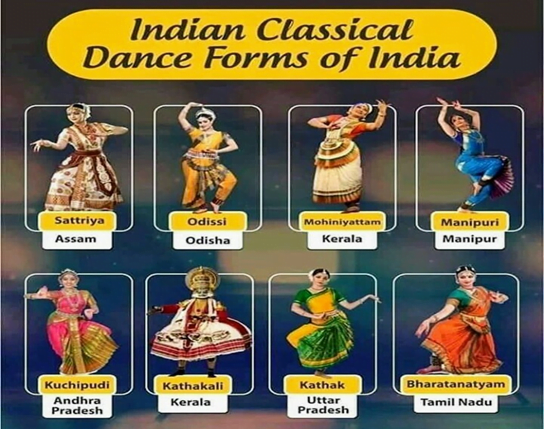
- Bharatanatyam: Tamil Nadu
- Kathak: Northern India
- Kathakali: Kerala
- Kuchipudi: Andhra Pradesh
- Manipuri: Manipur
- Mohiniaattam: Kerala
- Odissi: Odisha
- Sattriya: Assam
- Chhau: Odisha
Source: The Hindu
Previous Year Questions
Q.1) Which one of the following was given classical language status recently? (2015)
- Odia
- Konkani
- Bhojpuri
- Assamese
Syllabus
- Prelims – Science and Technology
Context: According to sources, the work on India’s first-ever night sky sanctuary in Ladakh will be completed in a month.
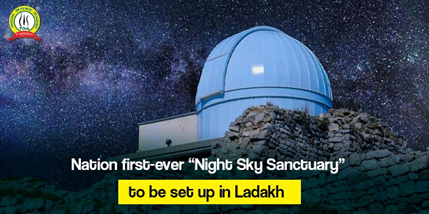
About the Sanctuary:
- It is being set up by Council of Scientific and Industrial Research under Union Ministry of Science & Technology.
- The proposed Dark Sky Reserve will be located at Hanle in Ladakh as a part of Changthang Wildlife Sanctuary.
- The Changthang Wildlife Sanctuary is a high altitude wildlife sanctuary located in the Ladakh adjunct of the Changthang plateau.
- It will boost Astro tourism in India and will be one of the world’s highest-located sites for optical, infra-red, and gamma-ray telescopes.
- Hanle is located in Ladakh’s cold desert region, away from any form of human disturbance with clear sky conditions and dry weather conditions that exist throughout the year.
Source: The Hindu
Previous Year Questions
Q.1) Consider the following phenomena
- Light is affected by gravity.
- The Universe is constantly expanding.
- Matter warps its surrounding space-time.
Which of the above is/are the prediction/predictions of Albert Einstein’s General Theory of Relativity, often discussed in media ?
- 1 and 2 only
- 3 only
- 1 and 3 only
- 1, 2 and 3
Syllabus
- Prelims – Governance
Context: Department of Water Resources organised the concluding event of the Young Water Professional Programme in collaboration with Western Sydney University, Australia and the Indian Institute of Technology.
About India Young Water Professional Programme:
- The National Hydrology Project, Department of Water Resources initiated this innovative 11-month-long programme with the objective to build the capacity of Young Water Professionals and provide them with the required knowledge, skills, attitude, and aptitude to offer their best in the country’s water sector by accepting leadership roles and responsibilities.
- This programme focuses on gender equality and diversity.
- The first phase of this Programme selected 20 young officers from the National Hydrology Project’s central and state implementing agencies.
- Progress and Relevance: the Australia India Water Centre brought together eight universities and one state government department from Australia and 16 IITs and key universities of India.
- India and Australia are natural partners and this collaboration to train young water professionals is an important step in the right direction.
Source: NewsOnAir
Syllabus
- Mains – GS 2 (Governance)
Context: Recently, the Tamil Nadu government has defended Jallikattu in the Supreme Court stating that the Jallikattu has both religious and cultural significance for the people of Tamil Nadu and its influence is beyond the confines of caste and creed. The State protested that the ban on Jallikattu was perceived as an onslaught against the cultural identity of the people of Tamil Nadu.
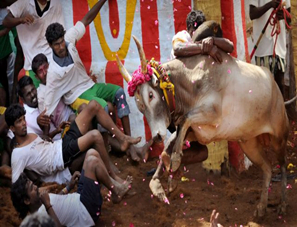
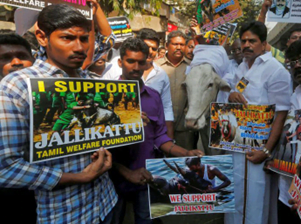
About Jallikattu:
- Jallikattu is a bull taming competitive sport and a tradition over 2,000 years old in part of Tamil Nādu.
- The word ‘Jallikattu’ has evolved from the words ‘Calli’ (coins) and ‘Kattu’ (tie), which denote a bundle of coins tied to the bull’s horns.
- There are references of Jallikattu in Silappatikaram, the great epics of Tamil classical period.
- It is celebrated in the second week of January, during the Tamil harvest festival, Pongal.
- It is popular in Madurai, Tiruchirappalli, Theni, Pudukkottai and Dindigul districts of Tamil Nadu known as the Jallikattu belt.
- The most popular Jallikattu is the one celebrated at Alanganallur near Madurai.
History of the event:
- Jallikattu has been known to be practiced during the Tamil classical period (400-100 BC).
- It was common among the Ayyar people who lived in the ‘Mullai’ geographical division of the ancient Tamil country.
- Later, it became a platform for display of bravery and prize money was introduced for participation encouragemen
- A seal from the Indus Valley Civilization depicting the practice is preserved in the National Museum, New Delhi.
- A cave painting in white kaolin discovered near Madurai depicting a lone man trying to control a bull is estimated to be about 1,500 years old.
Timeline of Legal issues of Jallikattu:
- Jallikattu first came under legal scrutiny in early 2000s when the Animal Welfare Board of India and the animal rights group People for the Ethical Treatment of Animals (PETA) moved petitions in the Supreme Court against Jallikattu as well as bullock cart races.
- In 2011, the Environment Ministry at the Centre issued a notification specifically mentioning ‘bulls’.
- The Jallikattu practice continued to be held because of the Tamil Nadu Regulation Act No. 27 of 2009 even after the 2011 notice.
- The Animal Welfare Board of India (AWBI) and PETA filed a petition in the Supreme Court again and contested that –
- The regulations were not being followed and that bulls were indeed being subjected to cruelty as defined under the Prevention of Cruelty to Animals Act, 1960.
- The Supreme Court in its 2014 verdict banned Jallikattu and struck down the Tamil Nadu Regulation of Jallikattu Act, 2009.
- In January 2016, in what could be seen as a clearly political move, the union environment ministry revoked the ban by issuing a notification months before the elections in Tamil Nadu were due to be held.
- The Supreme Court stayed this 2016 Union Government notification, as it was challenged by the AWBI and PETA.
- In January 2017, several hundreds of protesters conducted a rally at Chennai Marina opposing the ban on Jallikattu.
- Tamil Nadu passed the Prevention of Cruelty to Animals (Tamil Nadu Amendment) Act of 2017 and Prevention of Cruelty to Animals (Conduct of Jallikattu) Rules of 2017.
- The statutes had re-opened the gates for the conduct of the popular bull-taming sport in the name of culture and tradition despite the 2014 ban by the Supreme Court.
- In the aftermath of Jallikattu comeback due to Tamil Nādu legislation the Supreme Court had referred a bunch of petitions to the Constitution Bench in February 2018.
Arguments against the Jallikattu:
- Ethical issues: An investigation by the Animal Welfare Board of India concluded that “Jallikattu is inherently cruel to animals”.
- Human deaths: The event has caused several human deaths and injuries and there are several instances of fatalities to the bulls.
- Cruelty to animal: A report submitted by the AWBI before the Supreme Court in this case highlighted unimaginable torture inflicted- tails twisted and fractured, chemicals poured into eyes, ears mutilated, sharp edged weapons used to poke the animal.
- Manhandling of animals: Animal welfare concerns are related to the handling of the bulls before they are released and also during the competitor’s attempts to subdue the bull.
Arguments in favour of Jallikattu:
- Cultural Representation: There exists tangible evidence to show that this battle between man and beast is a cultural representation.
- Agrarian Economy: The political economy of such games is about showcasing the quality of cattle, the breeding skills of cattle rearers, the centrality of cattle in an agrarian economy, and the power and pride they bring to farmers.
- Agrarian Culture: Such games are a cultural manifestation of this political economy. As a tradition, it links an agrarian people to the elemental aspect of their vocation.
- Symbol of Tamil Culture: Jallikattu’s linkages with Pongal has lifted it above its regional and community origins and transformed it into a symbol of Tamil culture and pride.
- Shapes Political Discourse: Pride in Tamil culture is central to Dravidian nationalism, which continues to shape the political discourse in Tamil Nadu.
Way Forward:
Although there are systems in place to check treatment of the bulls and ensure safety of participants and spectators, animal cruelty still continues and people continue to lose their lives. There needs to be a comprehensive regulatory framework in place with zero implementation gaps to check treatment of animals and ensure safety of participants and spectators.
Source: The Hindu
Additional Information:
About Animal Welfare Board of India (AWBI)
- It is a statutory body established in 1962 under Section 4 of the Prevention of Cruelty to Animals Act, 1960.
- It is headquartered at Ballabgarh in Faridabad District of Haryana.
- The Board was initially within the jurisdiction of the Government of India’s Ministry of Food and Agriculture.
- In 1990, the subject of Prevention of Cruelty to Animals was transferred to the Ministry of Environment and Forests, where it now resides.
Composition:
- The Board consists of 28 Members, who serve for a period of 3 years.
Functions:
- It is an advisory body advising the Government of India on animal welfare laws, and promotes animal welfare in the country of India.
- It works to ensure that animal welfare laws in the country are followed and provides grants to Animal Welfare Organizations.
- It frames a range of rules on how animals ought to be humanely treated everywhere.
- It has also frequently litigated to have stricter laws to ensure animals were not unduly harassed or tortured.
Syllabus
- Mains – GS 2 (Governance)
Context: After more than 200 years of colonial rule, India became free at the stroke of midnight on August 15, 1947. The hard-earned independence was an outcome of a long-drawn freedom struggle which was uniting force among the India. Further the Adoption of Constitution of 26 Nov 1949, laid down the vision of founding father of nation for upcoming India and the day of 26 November is celebrated as ‘constitution day.’
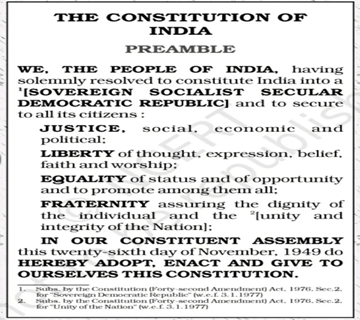
About Constitution Day:
- The Constitution of India was adopted by the Constituent Assembly on November 26, 1949 for ‘We the people of India’.
- After being unnoticed for long, only since 2015, the day has begun to be celebrated as Constitution Day. This day is indeed a historic day for the nation, with the framing of a constitution for the governance of independent India.
The historical events that shaped the constitutional framing:
- Inspiration from Tilak Swaraj Bill of 1895:
- Constitution had its inspiration in sources like Tilak’s Swaraj Bill of 1895 (which included rights to free speech, free press, equality before law) and
- The Declaration of Rights of 1918 (where the Indian National Congress demanded that civil and political rights to include the right to life and liberty, freedom of press and association and for all this to be included in the Government of India Act 1919).
- Karachi Session of the Congress in 1931: It is also a significant constitutional development that drew from the Resolution of Fundamental Rights and Economic Changes
- This resolution argues that “in order to end exploitation of the masses, political freedom must include economic freedom”. Along with fundamental rights, it provided for:
- ending of bonded and child labour,
- free primary education,
- expansion of labour welfare,
- regime protection labour unions, women workers,
- providing for redistribution of resources through state control over key industries and national resources,
- recognising the communal problem and laying out protection of minority rights.”
- All these demands would find their way into Part III (Fundamental Rights) and Part IV (Directive Principals of State Policy) of the Constitution.
The vision which conjoins the diverse people of India:
- Richard Kay writes that a people would submit to a constitution, when the constituent assembly crafts a narrative about the creation of the body that is both politically acceptable and historically plausible.
- It’s not only the text, but also the story crafted of the birth of a constitution that is critical in the internalisation of a constitutional order by a people.
- The drafters deployed the considerable political goodwill enjoyed by key national leaders who were members of the assembly to give legitimacy to the Constitution.
- These told a story of how the Constitution reflected the will of the people, and how its egalitarian foundation would create a better, more decent nation.
- Freedom struggle movements and resistance to colonial power was the uniting force that clubbed the people of India from diverse background and it was also good training for constitution-crafting.
Consensus-orientated method while adopting the significant provisions in the constitution:
- Framers of Constitution appreciated the link between consensus in adoption and the legitimacy of the Constitution.
- For instance, when debating the adoption of Hindi as a national language, Rajendra Prasad, president of the Constituent Assembly, said that the choice of national language would have to be “carried out by the whole country”.
- And that even if a majority of the Assembly made a choice that was not approved by a section of the people, then, implementation of the Constitution would be rendered perilous. Hence, Hindi was made “the official language of the Union”, while English was retained to be used for all “official purposes”.
- Yet, while the drafters opted for compromise and consensus in some areas, they made bold choices on others.
- For instance, breaking down traditional privileges like the
- abolition of princely states and royal titles, and
- crafting the country as a democracy based on universal adult franchise, and ending discrimination on grounds of caste, or sex or religion.
Way Forward:
- India’s drafters and the methodologies they adopted to craft their glorious product, hold lessons for contemporary politicians and law makers. Consensus, craft and vision are invaluable while making an instrument to endure.
- As, the Constitution empowers the people as much as the people empower the Constitution.
- It was the foresight, intellect and ingenuity of the great men in the Constituent Assembly that helped succeed in framing a constitution whose acceptability has only grown with each passing generation.
- It is also a time to salute the common citizen of the country who has established an unbreakable bond with the letter and spirit of the Constitution and has at every difficult juncture of our journey renewed her faith and commitment to the lofty ideals of our Constitution.
Therefore, With the completion of 75 years of our independence, we can justifiably take pride in our journey as a nation and our achievements in diverse fields. It is also a time to reaffirm our faith in our people and our Constitution as we enter Amrit Kaal and renew and rededicate our commitment to remain steadfast in achieving our dream of a new self-reliant, strong, united and humane nation in the next 25 years.
Source: Indian Express
Practice MCQs
Q.1) Consider the following statements regarding Sangeet Natak Academy:
- It is the apex body which was set up in 1953 for the preservation and promotion of the vast intangible heritage of India.
- The Chairman of the Akademi is appointed by the Vice President of India for a term of three years.
- It is an autonomous body of the Ministry of Culture, Government of India.
Which of the statements given above are correct?
- 1 and 2 only
- 2 and 3 only
- 1 and 3 only
- 1 2 and 3
Q.2) Consider the following statements regarding the Centre for Development of Telematics (C-DOT):
- It is a registered ‘public funded research institution’ with the Ministry of Communication and IT, Government of India.
- The Union Minister of Communication and IT acts as its President.
Which of the above statements is/are correct?
- 1 only
- 2 only
- Both 1 and 2
- Neither 1 nor 2
Q.3) The Kutia Kondh Tribes often mentioned in news belong to
- Andhra Pradesh
- West Bengal
- Madhya Pradesh
- Odisha
Comment the answers to the above questions in the comment section below!!
ANSWERS FOR ’26th November 2022 – Daily Practice MCQs’ will be updated along with tomorrow’s Daily Current Affairs.st
ANSWERS FOR 25th November – Daily Practice MCQs
Q.1) – a
Q.2) – c
Q.3) – c













